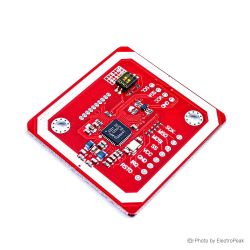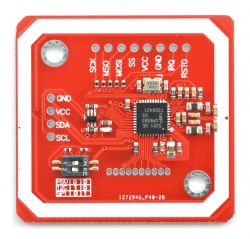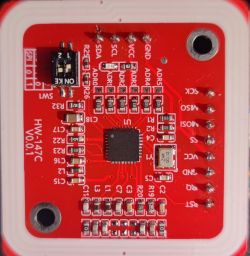Hello,
I have a PN532 RFID reader
 .
.
I have used it before, connecting it to an Arduino Nano. Now I have switched to ESP32, specifically ESP32-S3-WROOM-1, and a problem arises. In I2C mode, the scanner detects the reader, but in no way am I able to read any tag. Example program on I2C:
.
After switching to SPI, zero communication, example program:
.
But interestingly leaving exactly the same pins and changing the reader to RC522 everything works without any problem, code for RC522:
.
I found several threads on Reddit on this subject, but none of these solutions helped.
I have a PN532 RFID reader
 .
.
I have used it before, connecting it to an Arduino Nano. Now I have switched to ESP32, specifically ESP32-S3-WROOM-1, and a problem arises. In I2C mode, the scanner detects the reader, but in no way am I able to read any tag. Example program on I2C:
#include <Wire.h>
#include <Adafruit_PN532.h>
// Definiujemy piny I2C dla ESP32-S3
#define SDA_PIN 12
#define SCL_PIN 13
// Definiujemy piny IRQ i RESET (jeśli nie podłączone, zostaw -1)
#define IRQ_PIN -1
#define RESET_PIN -1
// Inicjalizacja PN532 przez I2C
Adafruit_PN532 nfc(IRQ_PIN, RESET_PIN);
void setup() {
Serial.begin(115200);
while (!Serial) delay(10); // Czekaj na otwarcie portu szeregowego
Serial.println("Inicjalizacja PN532 (I2C)...");
// Inicjalizacja I2C na ESP32-S3
Wire.begin(SDA_PIN, SCL_PIN);
Wire.setClock(100000); // Ustawienie prędkości I2C na 100 kHz
// Opóźnienie na stabilizację
delay(100);
// Inicjalizacja PN532
nfc.begin();
// Sprawdzenie komunikacji z PN532
uint32_t versiondata = nfc.getFirmwareVersion();
if (!versiondata) {
Serial.println(" Błąd: NIE WYKRYTO PN532 przez I2C!");
Serial.println(" Sprawdź połączenia SDA/SCL i tryb pracy modułu.");
while (1); // Zatrzymujemy program
}
Serial.print(" PN532 wykryty! Wersja firmware: 0x");
Serial.println((versiondata >> 24) & 0xFF, HEX);
Serial.print("Firmware ver. ");
Serial.print((versiondata >> 16) & 0xFF, DEC);
Serial.print('.');
Serial.println((versiondata >> 8) & 0xFF, DEC);
// Ustawienie czytnika w tryb odczytu kart NFC
nfc.SAMConfig();
Serial.println(" PN532 gotowy! Przyłóż kartę NFC...");
}
void loop() {
uint8_t uid[7]; // Tablica na UID karty
uint8_t uidLength;
Serial.println(" Czekam na kartę...");
// Sprawdzenie, czy karta jest w zasięgu
if (nfc.readPassiveTargetID(PN532_MIFARE_ISO14443A, uid, &uidLength)) {
Serial.println(" Karta wykryta!");
Serial.print(" UID Length: ");
Serial.print(uidLength, DEC);
Serial.println(" bytes");
Serial.print(" UID Value: ");
for (uint8_t i = 0; i < uidLength; i++) {
Serial.print(uid[i], HEX);
Serial.print(" ");
}
Serial.println("\n");
delay(2000); // Poczekaj przed kolejnym odczytem
} else {
Serial.println(" Brak karty w zasięgu.");
}
delay(500); // Krótkie opóźnienie przed kolejnym sprawdzeniem
}
After switching to SPI, zero communication, example program:
#include <SPI.h>
#include <Adafruit_PN532.h>
// Definiujemy piny SPI dla ESP32-S3
#define SS_PIN 42 // Chip Select (CS) – Możesz zmienić
#define SCK_PIN 12
#define MISO_PIN 13
#define MOSI_PIN 11
// Tworzymy obiekt PN532 dla SPI
Adafruit_PN532 nfc(SS_PIN, &SPI);
void setup() {
Serial.begin(115200);
Serial.println("Inicjalizacja PN532 (SPI)...");
// Inicjalizacja SPI z wymuszeniem pinów
SPI.begin(SCK_PIN, MISO_PIN, MOSI_PIN, SS_PIN);
SPI.beginTransaction(SPISettings(100000, MSBFIRST, SPI_MODE0)); // Zmniejszona prędkość SPI
// Inicjalizacja czytnika PN532
nfc.begin();
uint32_t versiondata = nfc.getFirmwareVersion();
if (!versiondata) {
Serial.println("Błąd: NIE WYKRYTO PN532 przez SPI!");
Serial.println("Sprawdź połączenia i tryb SPI.");
while (1); // Zatrzymujemy program
}
Serial.print("PN532 wykryty! Wersja firmware: 0x");
Serial.println((versiondata >> 16) & 0xFF, HEX);
// Ustawienie czytnika w tryb odczytu NFC
nfc.SAMConfig();
Serial.println("PN532 gotowy! Przyłóż kartę NFC...");
}
void loop() {
uint8_t uid[7]; // UID karty
uint8_t uidLength;
Serial.println("Czekam na kartę...");
// Sprawdzenie obecności karty
if (nfc.readPassiveTargetID(PN532_MIFARE_ISO14443A, uid, &uidLength)) {
Serial.println("Karta wykryta!");
Serial.print(" UID Length: ");
Serial.print(uidLength, DEC);
Serial.println(" bytes");
Serial.print(" UID Value: ");
for (uint8_t i = 0; i < uidLength; i++) {
Serial.print(uid[i], HEX);
Serial.print(" ");
}
Serial.println("\n");
delay(2000); // Poczekaj przed kolejnym odczytem
} else {
Serial.println("Brak karty w zasięgu.");
}
delay(500); // Krótkie opóźnienie przed kolejnym sprawdzeniem
}
But interestingly leaving exactly the same pins and changing the reader to RC522 everything works without any problem, code for RC522:
/*
* --------------------------------------------------------------------------------------------------------------------
* Example showing how to read data from a PICC to serial.
* --------------------------------------------------------------------------------------------------------------------
* This is a MFRC522 library example; for further details and other examples see: https://github.com/OSSLibraries/Arduino_MFRC522v2
*
* Example sketch/program showing how to read data from a PICC (that is: a RFID Tag or Card) using a MFRC522 based RFID
* Reader on the Arduino SPI interface.
*
* When the Arduino and the MFRC522 module are connected (see the pin layout below), load this sketch into Arduino IDE
* then verify/compile and upload it. To see the output: use Tools, Serial Monitor of the IDE (hit Ctrl+Shift+M). When
* you present a PICC (that is: a RFID Tag or Card) at reading distance of the MFRC522 Reader/PCD, the serial output
* will show the ID/UID, type and any data blocks it can read. Note: you may see "Timeout in communication" messages
* when removing the PICC from reading distance too early.
*
* If your reader supports it, this sketch/program will read all the PICCs presented (that is: multiple tag reading).
* So if you stack two or more PICCs on top of each other and present them to the reader, it will first output all
* details of the first and then the next PICC. Note that this may take some time as all data blocks are dumped, so
* keep the PICCs at reading distance until complete.
*
* @license Released into the public domain.
*
* Typical pin layout used:
* -----------------------------------------------------------------------------------------
* MFRC522 Arduino Arduino Arduino Arduino Arduino
* Reader/PCD Uno/101 Mega Nano v3 Leonardo/Micro Pro Micro
* Signal Pin Pin Pin Pin Pin Pin
* -----------------------------------------------------------------------------------------
* SPI SS SDA(SS) 10 53 D10 10 10
* SPI MOSI MOSI 11 / ICSP-4 51 D11 ICSP-4 16
* SPI MISO MISO 12 / ICSP-1 50 D12 ICSP-1 14
* SPI SCK SCK 13 / ICSP-3 52 D13 ICSP-3 15
*
* Not found? For more see: https://github.com/OSSLibraries/Arduino_MFRC522v2#pin-layout
*/
#include <MFRC522v2.h>
#include <MFRC522DriverSPI.h>
//#include <MFRC522DriverI2C.h>
#include <MFRC522DriverPinSimple.h>
#include <MFRC522Debug.h>
MFRC522DriverPinSimple ss_pin(42); // Configurable, see typical pin layout above.
MFRC522DriverSPI driver{ss_pin}; // Create SPI driver.
//MFRC522DriverI2C driver{}; // Create I2C driver.
MFRC522 mfrc522{driver}; // Create MFRC522 instance.
void setup() {
Serial.begin(115200); // Initialize serial communications with the PC for debugging.
while (!Serial); // Do nothing if no serial port is opened (added for Arduinos based on ATMEGA32U4).
mfrc522.PCD_Init(); // Init MFRC522 board.
MFRC522Debug::PCD_DumpVersionToSerial(mfrc522, Serial); // Show details of PCD - MFRC522 Card Reader details.
Serial.println(F("Scan PICC to see UID, SAK, type, and data blocks..."));
}
void loop() {
// Reset the loop if no new card present on the sensor/reader. This saves the entire process when idle.
if ( !mfrc522.PICC_IsNewCardPresent()) {
return;
}
// Select one of the cards.
if ( !mfrc522.PICC_ReadCardSerial()) {
return;
}
// Dump debug info about the card; PICC_HaltA() is automatically called.
MFRC522Debug::PICC_DumpToSerial(mfrc522, Serial, &(mfrc522.uid));
}
I found several threads on Reddit on this subject, but none of these solutions helped.








